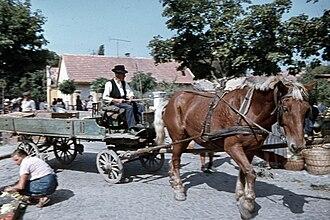
Continent: Europe
Country: Hungary
Weight: 700 – 900 kg
Height: 155 – 165 cm

The Hungarian Draft Horse (Magyar hidegvérű in Hungarian, literally "Hungarian cold-blood") is a breed of heavy draft horse originating from Hungary.
It developed from the 19th century through crosses between local rustic horses and heavy European breeds, mainly the Belgian Draft, the Ardennes, the Percheron, and the Noriker.
The aim was to create a powerful and resilient horse, well adapted both to agricultural work and to the climate of the Hungarian Great Plain.
The Hungarian Draft is bred mainly in the Great Hungarian Plain, the country’s historic agricultural region. It was here that it was selected to meet the needs of field traction and heavy transport.
Prestigious studs such as Mezőhegyes, Hortobágy, and Szilvásvárad played a key role in the development and preservation of the breed. These centers remain important hubs for the conservation and promotion of the Hungarian Draft Horse.
The breed is also found in Romania, Slovakia, Serbia, and Austria, where the Hungarian Draft was exported for its qualities of strength and docility. In these regions, it is used for traditional farming, driving, and sometimes pulling contests.
The Hungarian Draft Horse is considered a symbol of Hungarian peasant breeding. Designed to meet agricultural needs, it represents a valuable genetic heritage, resulting from crosses between local horses and Western draft breeds.
Thanks to its powerful build and robustness, the Hungarian Draft has been used to strengthen other draft horse lines in Central and Eastern Europe. Its contribution has helped improve pulling strength and endurance in certain local populations.
With the advent of agricultural mechanization, its numbers declined sharply, but it remains an important genetic resource. Current conservation programs highlight its value in preserving equine biodiversity and in maintaining cultural and rural traditions.
The Hungarian Draft emerged during the 19th century, when Hungary sought to develop a national draft horse able to compete with major Western breeds. Breeders crossed local rustic horses with heavy breeds such as the Belgian Draft, Ardennes, Percheron, and Noriker, to obtain a powerful and resilient type adapted to the continental climate of Hungary.
Prestigious establishments such as Mezőhegyes, Hortobágy, and Szilvásvárad were at the heart of this selection. These studs implemented strict breeding policies to establish the breed’s traits, ensuring both pulling strength and docility.
During the first half of the 20th century, the Hungarian Draft experienced significant expansion. It was widely used in agriculture, transport, and the army, where its strength and reliability were highly valued.
With the advent of agricultural mechanization in the 1950s–1970s, the demand for draft horses plummeted. Like many other European draft breeds, the Hungarian Draft was relegated to a secondary role, and its numbers drastically declined.
Today, though endangered, the Hungarian Draft remains a living symbol of rural Hungarian culture. It is promoted in traditional festivals, pulling contests, and conservation programs that aim to preserve this genetic and cultural heritage.
The Hungarian Draft is known for its gentle and steady nature. It is a patient horse, remaining stable even in noisy or stressful environment.
Thanks to its docility and practical intelligence, it is easy to train. This makes it a reliable partner for farm work, as well as for leisure or show driving.
Despite its imposing build, the Hungarian Draft is famous for its kindness and controlled power. It is not aggressive and willingly accepts the company of humans and other horses.
Hardy and sociable, it integrates well into semi-feral herds. Its calm nature limits hierarchical conflicts with other horses.
"A gentle giant with a tender heart, calm and dependable, embodying the patience and quiet strength of draft horses."
The Hungarian Draft has seen its numbers greatly reduced since the mechanization of agriculture. Today, the breed is classified as endangered, with populations mainly concentrated in traditional farms.
Several preservation programs have been launched by national studs and breeders’ associations. They aim to maintain the breed’s genetic diversity and to encourage reproduction under controlled conditions.
The horse retains a strong heritage value in Hungary. It can be seen at rural festivals, in driving demonstrations, and in certain touristic activities (carriage rides, shows). These initiatives help maintain both economic and cultural interest in the breed.
Although its agricultural use has sharply declined, the Hungarian Draft may find a future in:
The Hungarian Draft is a robust and hardy horse, selected to withstand the sometimes extreme conditions of the Hungarian Great Plain. It tolerates both harsh winters and hot, dry summers.
As with most heavy breeds, some weaknesses may occur:
Overall, the Hungarian Draft enjoys good longevity for a draft horse. Regular veterinary care, proper weight management, and moderate exercise help maintain its physical abilities for many years.
Its selection as an agricultural draft animal has shaped a breed capable of delivering sustained effort without major fragility. When well maintained, the Hungarian Draft remains a sound and reliable horse, even into old age.